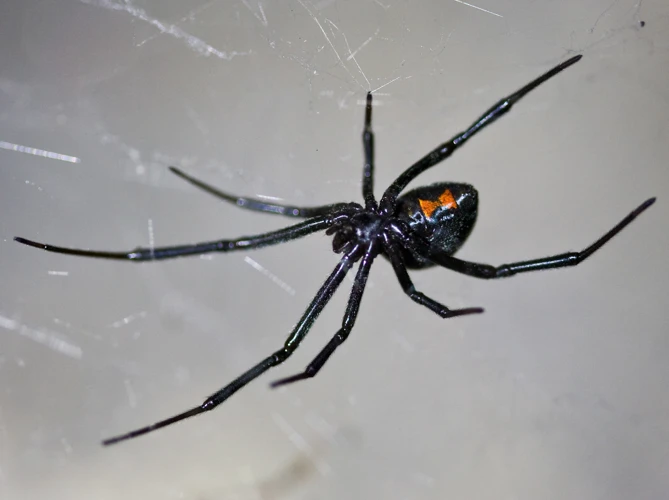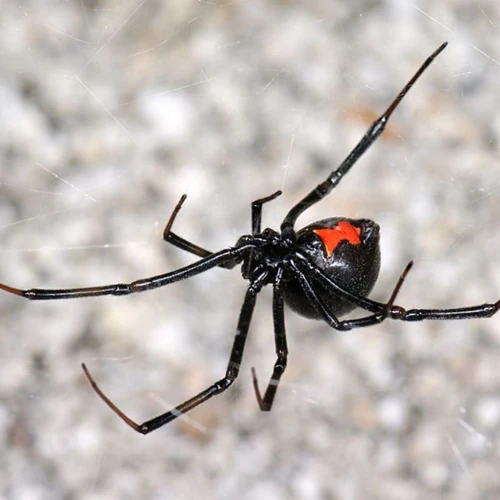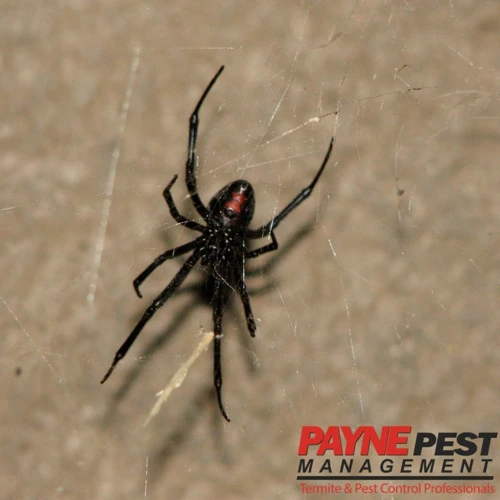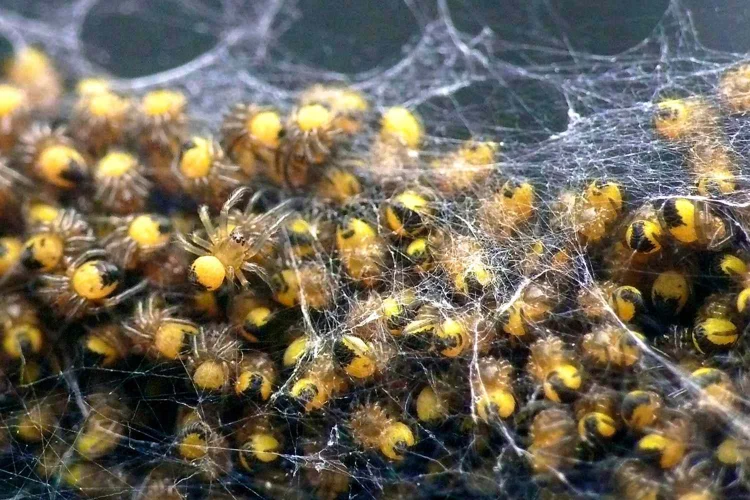Introduction

The world of black widow spiders is both fascinating and mysterious. These creepy crawlers, notorious for their poisonous bites, are also known for their unique reproductive process, which involves a complex system of egg development stages. For those who are intrigued by the intricacies of spider life, understanding the developmental stages of black widow spider eggs is a must. In this article, we will delve into the fascinating journey that black widow spider eggs undergo, from fertilization to hatching. So, sit back and prepare to explore the intriguing world of the black widow spider egg.
The Black Widow Spider – A Brief Overview
The black widow spider is a highly venomous, nocturnal arachnid, known for its unique and striking appearance. Mostly found in warm regions, these spiders are recognizable by the hourglass shape on their abdomens, which comes in various colors such as red, orange, or yellow. They are very territorial and one of the most dangerous spiders in their family. Despite their danger, they have a unique life cycle, especially when it comes to their eggs.
Black widow spiders are known for their unique maternal care. After mating, the female creates a web sac to serve as a protective shield for their eggs. The egg sac can contain hundreds of eggs, which the female spider will guard and groom tirelessly until they hatch.
Researchers have closely examined the developmental stages of black widow spider eggs. Egg hatching synchrony and black widow success have been studied to understand how long it takes for these eggs to hatch on average and how the synchronization of the hatching contributes to the success of the offspring. Some may even compare the black widow egg stage to other spider species or different organisms.
The pre-laying stage for black widow spiders is all about the quest for a perfect nest, which includes fertilization and building of the web. Apart from maternal care, black widow spiders also exhibit parental investment in their eggs, ensuring that the sac is well equipped for their offspring.
The developmental stage of black widow spider eggs is separated into three different and critical phases. Stage 1 involves the initiation and growth of the embryo. During stage 2, the formation of the yolk and chorion takes place. Finally, during stage 3, the egg cell is complete, and it prepares for hatching.
The hatching of black widow spider eggs is a momentous event for both the mother spider and the offspring. When hatching occurs, the spiderlings break free from the confines of the egg sac and emerge into the world. The duration of hatching and the count of egg sacs can vary, depending on the environmental factors and geographic location.
Studying the world of black widow spider eggs has brought forth a wealth of knowledge and intrigue. Researchers continue to investigate various aspects of black widow spider eggs, including sex determination and egg studies. With more studies, we will gain a greater understanding of these creepy crawlers and their unique life cycle.
Pre-Laying Stage – the Quest for a Perfect Nest

As we delve deeper into the world of black widow spiders, it becomes apparent that their life cycle is just as intricate and captivating as their appearance. One of the most crucial stages in their life cycle is the pre-laying stage, where the female spider goes on a quest for the perfect nest. During this stage, the spider undergoes various preparations to ensure that her eggs have the best possible start in life. In this article, we will explore the pre-laying stage of the black widow spider and its significance in the overall egg developmental process. For more insights into the maternal care of black widow spider eggs, check out our previous article here.
Fertilization – the Beginning of the Journey
During the fertilization stage, the female black widow spider will mate with a male to produce fertilized eggs, marking the beginning of the journey of egg development. Contrary to the belief that female black widow spiders eat their mates, it only occurs in rare cases, and the male is usually allowed to live.
After copulation, the female black widow spider secretes a liquid that envelops the fertilized eggs, which protects them from outside threats such as predators or fungal infections. This process is called “silk wrapping,” during which the female spins silk threads around or over the egg sac. Silk wrapping is an essential part of the pre-laying stage, and it serves as a protective barrier against temperature fluctuations, predators, and other danger.
The fertilized eggs will hatch in about 31-36 days, depending on the temperature and humidity levels. Interesting research conducted on black widow spider eggs indicates that if eggs are subjected to extremely cold conditions, they can remain dormant until optimal temperatures resume.
Black widow spider females bestow a significant amount of energy and maternal care in egg production. As a result, they produce fewer eggs compared to some other spider species, but they compensate for it by investing more energy to ensure the success of each egg. If you’re interested in learning more about the maternal care of black widow spiders, check out our article on parental investment in black widow eggs.
The fertilization stage marks the beginning of the journey of egg development. The eggs’ health and development depend highly on environmental factors and the mother’s care. In the next section, we will discuss the steps that follow as the egg begins to develop through various stages of growth.
Building the Web – Preparing for the Arrival of All Important Eggs
During the pre-laying stage, Black Widow Spiders focus on constructing a web that will be strong enough to support their precious egg sacs. Building the web is a crucial step in preparing for the arrival of all important eggs. The female spider’s web is made of protein-based silk that she produces herself. The silk is spun into a dense, cotton-like ball, which serves as a protective shield for the sac of eggs.
Interestingly, the female spider constructs a different type of web compared to the one she uses for hunting prey. The egg sac web is typically located in a dry, hidden location that is out of sight from predators. The web is carefully constructed to prevent moisture from getting in, as excess water can harm the eggs.
In some cases, the web also serves as a trap for capturing prey, which can serve as a food source for the mother spider. To increase the chances of catching prey, the web may be coated with a sticky substance that traps unsuspecting insects and other small creatures.
Once the web is constructed, the female Black Widow Spider will lay her egg sac inside, which looks like a round, papery sphere with a unique pattern on the surface. This egg sac can house hundreds of eggs all at once and can be guarded by the female spider until the eggs hatch.
Building the egg sac web is an essential step for Black Widow Spiders, which enables them to protect their eggs from moisture, predators, and secure a source of food. Visitors can learn more about hatching Black Widow eggs by clicking on this link.
Developmental Stages of the Egg

As the Black Widow Spider reaches the pre-laying stage, their quest for a perfect nest begins. Once the nest is ready, the spider moves onto the next phase – egg development. The female black widow spider lays several eggs, which then undergo a series of developmental stages, each with their unique characteristics that lead up to their eventual hatching. These stages are essential in understanding the life cycle of black widow spiders and can provide insights into the survival and success of the eggs. Let’s take a closer look at the developmental stages of the black widow spider egg. For a more detailed comparison of egg stages between different black widow spider species, check out this comparative study.
Stage 1: Initiation and Growth of Embryo
During the first stage of black widow spider egg development, initiation and growth of embryo, the fertilized egg begins to develop into an embryo. This process takes place within the first 24 hours of the egg being laid. The egg appears white initially, but gradually darkens over time due to a layer of pigmented cells that develops around it.
The embryo develops from a single cell and undergoes cleavage, a process in which the cell divides repeatedly to produce multiple cells. Cells continue to divide and differentiate into various organs and tissues. At this stage, the embryo is surrounded by a shell known as the vitelline envelope. The vitelline envelope is a protective barrier that provides the embryo with necessary nutrients for development.
One recent study on black widow spider eggs found that the average number of eggs in an egg sac was 256, with a range of 138 to 380 eggs. Another study discovered that the duration of egg hatching is dependent on temperature, taking anywhere from 10 to 30 days for eggs to hatch.
Interestingly, the sex of black widow spider offspring is determined by a unique and fascinating process known as haplodiploidy. This process involves the presence of two types of eggs within the egg sac: fertilized eggs, which produce female spiders, and unfertilized eggs, which produce male spiders.
The initiation and growth of the embryo is a crucial stage in black widow spider egg development. These eggs undergo several unique processes that lead to the ultimate development of the black widow spiders. If you want to learn more about black widow spider eggs, you may want to check out a recent study that was conducted on them.
Stage 2: Formation of Yolk and Chorion
During Stage 2 of Black Widow Spider egg development, the formation of yolk and chorion takes place. Yolk is an essential part of the egg, providing nutrients for the developing embryo inside. The chorion, on the other hand, acts as a protective barrier. The yolk is produced by the female spider’s reproductive system and secreted into the egg cells. The chorion, made of a proteinaceous material, subsequently surrounds the developing egg, forming a hard outer shell as protection against environmental influences.
The formation of both yolk and chorion is crucial for the successful development and eventual hatching of spider eggs. The yolk provides the necessary nutrients for the embryo’s growth, while the chorion protects the developing embryo from predators, parasites, and harmful environmental conditions.
Interestingly, the amount of yolk within an egg may also play a role in determining the sex of the developing spider. Research suggests that larger eggs containing more yolk tend to develop into female spiders, while smaller eggs with less yolk result in the development of male spiders. The amount and distribution of yolk within an egg may also influence the hatching synchrony of Black Widow Spider eggs, which in turn may impact their chances of survival.
To learn more about the intriguing world of Black Widow Spider eggs, including their hatching synchrony and how the number of egg sacs can affect spider success, don’t miss the related articles below:
- Temp Black Widow Egg
- Egg Hatching Synchrony and Black Widow Success
- Black Widow Eggs Hatch Duration
- Black Widow Egg Sac Count
- Sex Determination in Black Widow Spider Eggs
Stage 3: Completion of Egg Cell and Preparation for Hatching
During Stage 3, the egg cell of the black widow spider undergoes final development in preparation for hatching. At this stage, the embryo has fully developed and is ready to emerge from its protective casing. Let’s take a closer look at what happens during this stage.
| Process | Description |
|---|---|
| Eggshell Thickening | Differentiation and maturation of the cells that comprise the eggshell occur during this process. A thickened eggshell reduces water loss and provides physical protection for the developing embryo. |
| Yolk Absorption | The yolk, an essential nutrient source for the growing embryo, is absorbed through a narrow duct in the eggshell. This process allows the embryo to obtain the resources it needs for hatching and development. |
| Respiration | The embryo’s respiratory system develops during this stage, enabling the exchange of gases between the egg and the surrounding environment. Oxygen is obtained through tiny pores in the eggshell, while carbon dioxide is released. |
| Positioning | The embryo positions itself inside the egg to prepare for hatching. It may move to a specific location within the egg or orient itself in a particular direction. |
As Stage 3 progresses, the black widow spider egg is taking its final steps toward hatching. The thickened eggshell and absorbed yolk provide crucial protection and nutrition for the developing embryo. Meanwhile, the respiratory system develops to prepare the spiderling for its first breaths outside the egg. Finally, the spiderling positions itself in the egg and awaits the moment of emergence.
Hatching
After the long wait, the moment has finally arrived – the Black Widow Spider eggs are hatching! This is a crucial moment in the cycle of development of these creepy crawlies, as it marks the beginning of their journey towards adulthood. The process of hatching is a fascinating one, filled with wonder and intricacies that are both intriguing and perplexing. In this section, we’ll explore the dazzling emergence of the baby spiders from their protective egg sacs, and uncover the remarkable details of this final stage in the developmental process. Let’s dive in and discover the wonder of spider hatching!
Breaking Free – Shattering the Confines of the Egg
After spending several weeks in their eggs, Black Widow Spiderlings are ready to hatch and start their journey in the world. Hatching usually occurs in late summer or fall, and it’s a fascinating process to observe. During this stage, the spiderlings will struggle out of their egg sacs and try to break free from the confines of the egg.
The Breaking Free Process
Breaking free from the egg sac is not easy for the spiderlings. They have to use their egg teeth to create a small hole in the egg sac. Once they create the hole, they will start pushing their way out of the sac. The spiderlings will use their legs and their body weight to break open the sac, which can take several hours. During this process, the spiderlings are vulnerable to predators, and they have to be careful not to attract unwanted attention.
The Struggle for Survival
Once the spiderlings have fully emerged from the egg sac, they will start looking for food and shelter. They are tiny and vulnerable, and they have to be careful not to get caught by predators. The spiderlings will stick together in a group until they are big enough to fend for themselves. They will also start spinning their own webs as a means of protection and to capture prey.
The Importance of Hatching
Hatching is an essential stage in the life cycle of Black Widow Spiders. It’s during this stage that the spiderlings start their journey towards adulthood. Without hatching, the species would not be able to thrive and survive. It’s important to note that not all spiderlings will survive to adulthood. Many will fall prey to predators or succumb to harsh environmental conditions.
All in all, Black Widow Spiderlings breaking free from their egg sacs is a unique and fascinating process. It’s a crucial stage in their life cycle that sets the stage for their journey towards adulthood. The struggle for survival that follows hatching is a testament to the resilience and adaptability of these spiders.
Emergence – The Beautiful Start to the Ugly Crawler
The emergence of a black widow spider from its egg can be a fascinating sight to behold. After all the developmental stages have been completed, the spiderling is ready to break free from its confines and enter the world. The emergence process starts with the spiderling using its sharp egg tooth to break through the tough chorion layer of the egg. Once it has created a small hole, it will start applying pressure to the hole using its legs until it widens enough for it to crawl out.
Appearance
The emerging spiderling may not look very beautiful or attractive at first glance, but it is certainly a wonder of nature. It will be about 0.1 inches long and will look pale and translucent. Its body will be soft and pliable, and it will not have a hardened exoskeleton like an adult spider. It will also have only six legs at this stage, as the other two will develop after its first molt.
Behavior
Once the spiderling has emerged from its egg, it will be completely reliant on its yolk sac for nutrition for the first few days. During this time, it will not move around much and will remain close to its egg sac. However, as it grows stronger and more independent, it will start to move about more. It will instinctively start looking for food and will begin to spin its own silk threads to create a temporary web for protection.
Survival
The early stages of a black widow spiderling’s life can be very dangerous. Many predators, such as birds, frogs, and other spiders, see them as an easy meal. The spiderling will use its instinctual survival mechanisms to avoid detection, such as hiding under leaves, rocks, and other objects. It will also spin a small retreat web where it can hide when threatened.
Emergence marks the beginning of the black widow spiderling’s journey towards adulthood. While it may not look like much at first, it has all the potential to become a beautiful, yet feared, creepy crawler.
Conclusion
As we come to the end of our journey into the world of Black Widow Spider egg developmental stages, one can’t help but feel a sense of both fascination and perplexity. The intricate process of creating a safe and nurturing environment for the eggs, followed by the various stages of growth within, leading to the emergence of the not-so-cuddly spiderlings, is truly a wonder of nature. Let’s take a moment to ponder the insights we’ve gained and the lessons we’ve learned.
The Intriguing World of Black Widow Spider Eggs.
The world of black widow spider eggs is certainly an intriguing one. Considering the deadly nature of these spiders, one may think that their eggs would be just as dangerous. However, that is not the case. In fact, black widow spider eggs are a wonder to behold. Here are some interesting facts about these eggs:
| Fact | Description |
|---|---|
| The Silk | Black widow spider females construct a silk-layered egg sac to protect their offspring. |
| The Shape | The egg sacs are round and compact, with each sac containing up to 900 eggs. |
| The Developmental Stages | From inception to hatching, black widow spider eggs go through 3 main developmental stages. |
| The Color | Black widow spider eggs start off white and become yellow as they mature. |
| The Incubation | Black widow spider eggs are incubated for between 20-30 days before hatching. |
As you can see, these eggs are truly fascinating and show that even in the world of creepy crawlies, nature manages to produce things of wonder. It is important to note that although black widow spiders are venomous, their eggs are not considered dangerous to humans. Nevertheless, it is best to avoid disturbing these little ones at all costs.
Frequently Asked Questions
What is the ideal nesting site for black widow spiders?
The ideal nesting site for black widow spiders is a dry, sheltered area that is well protected from external elements.
How many eggs can a black widow spider lay at once?
A black widow spider can lay anywhere from 100 to 400 eggs per sac, with a single female capable of producing up to 20 sacs in a year.
How long does the egg-laying process take?
The egg-laying process for a female black widow spider can take anywhere from a few hours to a few days to complete depending on the size of the egg sac.
What is the role of the male black widow spider in the egg-laying process?
The male black widow spider plays a crucial role in fertilizing the female’s eggs, after which it is eaten by the female in a process called sexual cannibalism.
Can black widow spiders hatch their eggs without a proper nest?
No, black widow spiders require a proper nest which helps to regulate temperature and humidity to ensure that the eggs develop successfully.
What is the expected gestation period for black widow spider eggs?
The gestation period for black widow spider eggs is typically between 20 and 30 days, depending on external factors such as temperature and humidity.
What is the appearance of black widow spider eggs?
Black widow spider eggs are white or cream in color and are encased in a grayish, silk-like sac.
What is the success rate of black widow spider eggs hatching?
The success rate of black widow spider eggs hatching can vary depending on the environmental factors and predators in the area, but it is estimated that anywhere from 30-80% of the eggs will hatch.
How long does it take for black widow spiderlings to mature into adults?
It typically takes black widow spiderlings anywhere from 3 to 12 months to mature into adults, during which time they shed their skin multiple times.
Is it dangerous to handle black widow spider eggs?
It is not recommended to handle black widow spider eggs as female black widows can be highly aggressive and venomous, and their bites can be potentially fatal to humans.






